

Part One + Two - Washington's Culture Of Secrets, Sources And Leaks. -----------------------------------------------x Plaintiff, :
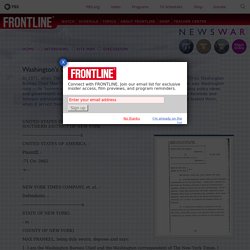
Whither Moral Courage? Free Speech Cases. Branzburg v. Hayes. Collin v. Smith, 578 F.2d 1197 (1978) (Cite as: 578 F.2d 1197) Frank COLLIN and the National Socialist Party of America, Plaintiffs‑Appellees,
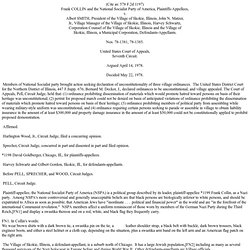
Turner Broadcasting System v. FCC. Argument of H.

Bartow Farr, III Chief Justice Rehnquist: We'll hear argument now in Number 95-992, the Turner Broadcasting System v. The Federal Communications Commission. Mr. Smith v. Daily Mail Publishing Co. Argument of Cletus B.
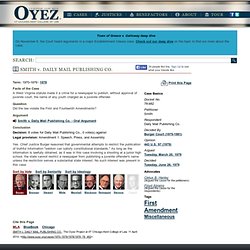
Hanley. Landmark Communications, Inc. v. Virginia. Argument of Floyd Abrams.
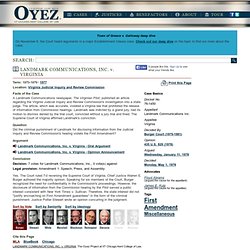
Near v. Minnesota. Opinion HUGHES, C.J., Opinion of the Court MR.
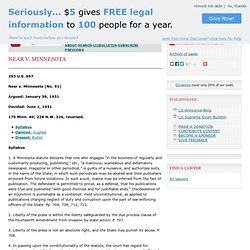
CHIEF JUSTICE HUGHES delivered the opinion of the Court. Chapter 285 of the Session Laws of Minnesota for the year 1925 [n1] provides for the abatement, as a public nuisance, of a "malicious, scandalous and defamatory newspaper, [p702] magazine or other periodical. " Section one of the Act is as follows: H. et al v. EASTON AREA SCHOOL DISTRICT. Texas v. Johnson. Argument of Kathi Alyce Drew Chief Justice William H.
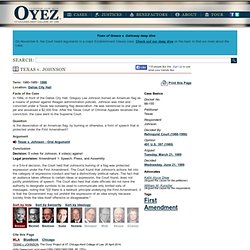
Richmond Newspapers Inc. v. Virginia. United States v. Stevens. Chief Justice John G.
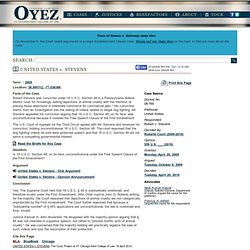
Roberts: We will hear, first, this morning, Case 08-769, United States v. Stevens. Mr. Katyal. Neal K. Ten years ago, in Section 48 of Title 18, Congress crafted a narrowly targeted restriction against certain depictions of actual animal cruelty. Yet the Third Circuit struck the statute down on its face without even attempting to apply substantial overbreadth analysis. The statute has four critical features and, just as the Court last year in United States v. First, like the statute at issue in the United States v.
Second, the statute only applies to commercial messages, ones that Congress found drove the market for animal cruelty. Third, the statute examines the work as a whole-- Justice Sonia Sotomayor: What record do you have of that fact? Pell v. Procunier - 417 U.S. 817 (1974. New York Times Co. v. United States - 403 U.S. 713 (1971. United States v. O'Brien. Argument of Griswold Chief Justice Earl Warren: Number 232 and 233, United States, Petitioner, versus David Paul O'Brien; and David Paul O'Brien, Petitioner, versus United States.
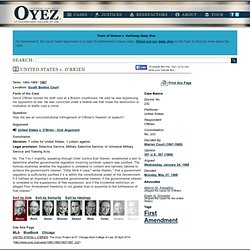
Cohen v. Cowles Media Co. Argument of Elliot C.
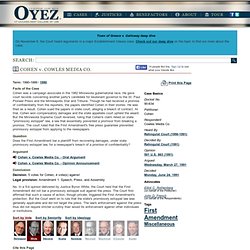
Rothenberg Chief Justice Rehnquist: We'll hear argument now in No. 90-634, Dan Cohen v. the Cowles Media Company, doing business as Minneapolis Star and Tribune Company. Cohen v. Cowles Media Co. View this case and other resources at: Citation. 22 Ill. 501 U.S. 663, 111 S. Ct. 2513, 115 L. Ed. 2d 586, 18 Med. L. Cohen v. Cowles Media Co. Freedom of the press/media/information.
Online Freedom. Going in Circles With Hate Speech. No topic is more frequently debated with less resolution than hate speech. This is made abundantly clear in a new collection of essays written by some of the leading contributors to the debate. The volume is called “The Content and Context of Hate Speech: Rethinking Regulation and Responses,” and it is edited by Michael Herz and Peter Molnar.
What you learn in the course of reading this book is that there is no generally accepted account of (1) what hate speech is, (2) what it does (what its effects are) and (3) what, if anything, should be done about it. To be sure, everyone agrees that it is hate speech when words are used to directly incite violence against a specific person or group of persons.
But as Arthur Jacobson and Bernhard Schlink point out in their contribution to the volume, on such occasions the words are instrumental “to an incipient assault,” and it is the assault, not the words, that the state criminalizes. The rest are all hard cases. Infamous scribblers: the founding fathers and the rowdy beginnings of ... - Eric Burns. Nothing But The Truth. Pawned laptop leads to child porn conviction for man. Using War as Cover to Target Journalists. Oliver Weiken/European Pressphoto Agency Journalists in Israel photographing the remains of a rocket that landed by a factory in Netivot. “Targeting journalism has become a trend, and now the people who are harassing and killing journalists include governments as well as the people you would expect,” said Mr. Rusbridger, who, along with others, was honored at the gathering in New York.
Journalists who dig into murky and dangerous corners of the world have become accustomed to being threatened and sometimes hunted by drug lords and gangsters, but now some governments have decided shooting the messenger is a viable option. The C.P.J. reports that government officials and their allies are now suspected of being responsible for more than a third of the murders of journalists, a higher proportion than killings attributed to terrorist groups or criminal enterprises. On the same day as the Waldorf event, three employees of news organizations were killed in Gaza by Israeli missiles. S.F. subway muzzles cell service during protest.
The operators of the Bay Area Rapid Transit subway system temporarily shut down cell service last night in four downtown San Francisco stations to interfere with a protest over a shooting by a BART police officer, a spokesman for the system said today. "BART staff or contractors shut down power to the nodes and alerted the cell carriers," James Allison, deputy chief communications officer for BART, told CNET.
The move was "one of many tactics to ensure the safety of everyone on the platform," he said in an initial statement provided to CNET earlier this afternoon. Activists had planned to protest the fatal shooting of Charles Blair Hill, who BART police said went after them with a knife before an officer shot him on July 3. "Organizers planning to disrupt BART service...stated they would use mobile devices to coordinate their disruptive activities and communicate about the location and number of BART police," said the original BART statement.
Eur-lex.europa.eu/LexUriServ/LexUriServ.do?uri=OJ:C:2010:083:0389:0403:en:PDF. New York Times Co. v. United States. PEOPLE v. BRYANT, Docket No. 141741., June 28, 2012 - MI Supreme Court. Hazelwood School District v. Kuhlmeier.